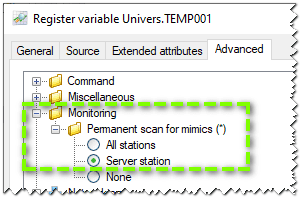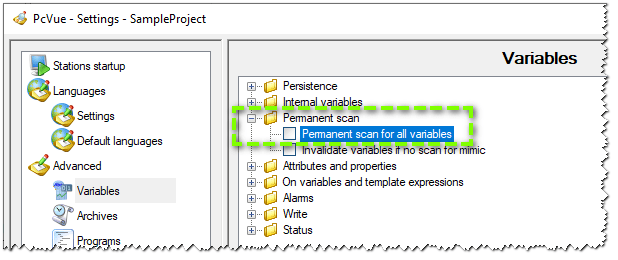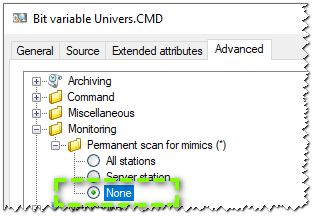Topic
[KB728]Reducing client startup time by using SynchronisationByCache
| Applies to:PcVue 10.0 SP1 and later | ||
|
|
||
| Summary:The SynchronisationByCache key can be added to a project’s VARCONF.DAT file to reduce the startup time of a client station. This is for client workstations, but the setting is taken into account on the server workstation. | ||
|
|
||
| Details:The following key can be added to a project’s VARCONF.DAT file to reduce the startup time of a client station.
[LOCALSERVER\Subscribe] LOCALSERVER key MUST NOT be replaced with the station name ! The setting informs the server station not to request the latest value of a variable from the source device. Instead it presents the most recent value that it has in its memory to the client. The theoretical performance gain is the amount of time that it would take to request the value from the device and to wait for its response, multiplied with the amount of variables subscriptions that need to be processed by the server station. This option is used for variable sources other than internal. Detailed behavior When the Variable Manager receives a subscription request the behavior is as follows. IF the VTQ of variable is refreshed (the variable is connected to the device and has been refreshed by it, the VTQ can be NSCOM if the device is not accessible) THEN Immediate acknowledgment of the subscription with the current VTQ (which would be the normal case where all is well with communication) ELSE IF the variable is already subscribed but the VTQ is not yet refreshed THEN THEN Immediate acknowledgment of the subscription with the current VTQ (VTQ that the server/Asso has in its cache) ELSE IF the variable is not already subscribed THEN (if NSCOM/NSLAN… = not initialized at client level ; and since it’s suscribe in the Manager PcVue sense, it only makes sense if you’ve unchecked the Permanent Mimic Scan option.) IF SynchronizationByCache = true THEN Immediate acknowledgment of the subscription with the current VTQ (VTQ that the server/Asso has in its cache) VTQ means Value, Timestamp and Quality. When you load a variable from its configuration, the Quality is initialized to Bad, the Timestamp is the timestamp at loading and the value is: On the first reception of a request for subscription, if the variable is produced and if the source is not internal then a subscription is sent to the device. When the device responds with a Value (and timestamp if the protocol is timestamped) the VTQ is updated and its status is set to refreshed. If the variable is consumed, the subscription is redirected to the producer server or association. The producer sends the response containing the VTQ, from which the VTQ of the variable will be refreshed. Refreshed means up to date with the device. In the case where the active producer station is subscribed to the variable, the VTQ of the client and the server are identical:
On the other hand, if the active producer station is not subscribed, the VTQ in memory corresponds to the last time it was subscribed, perhaps 1h or 2h or 24h or more ago. It is a possible scenario if the general setting regarding the permanent scan for mimic is not set:
And the variable is not subscribed by the server:
So when the client subscribes to the variable, the server returns the current VTQ and makes a request to the device associated with the variable to retrieve its VTQ. When the device returns the VTQ, if it is different from the cache then the server updates its cache and sends it to the client. We see that in this case the client can receive an old value before obtaining the current value. |
||
|
|
||
|
|
Created on: 05 Feb 2015 Last update: 27 Mar 2025


